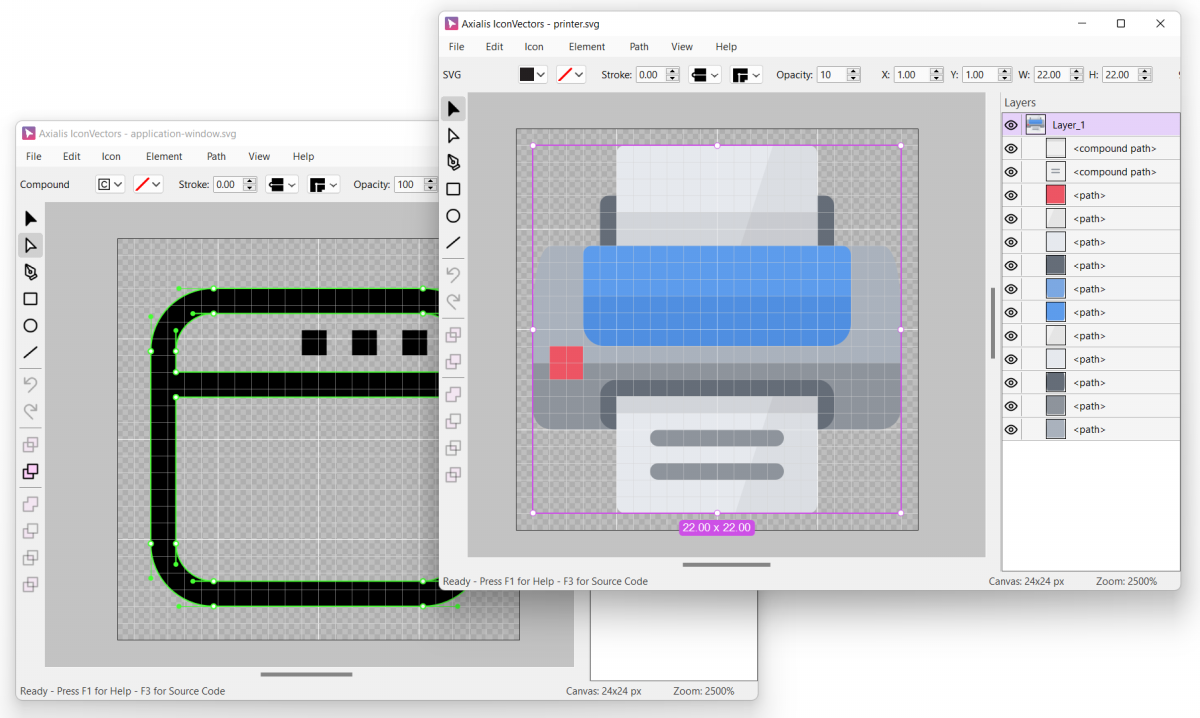Working With Documents
Axialis IconVectors offers several ways to open, save, and export SVG icons, ensuring seamless integration with your development and design workflows. It also includes a helpful shell extension to improve icon browsing in Windows Explorer.
Vector-Based Documents
Axialis IconVectors uses SVG (Scalable Vector Graphics) as its native format. This means icons that you can edit with IconVectors are composed of paths, shapes, and other vector elements rather than pixels. The key benefit is that your artwork can scale to any size without losing clarity or sharpness.
Supported File Formats
Axialis IconVectors works with SVG (Scalable Vector Graphics) files, a widely adopted standard for vector-based drawings. The application is optimized for editing small vector assets such as icons, but it is capable of opening and displaying SVG documents of any size or complexity.
When you create or save a document in IconVectors, it is stored in SVG format. This ensures compatibility with a wide range of tools and platforms, including web browsers, development frameworks, and other design software.
Note
While you can export your icons in other formats such as XAML, VueTS, or bitmap images (PNG, ICO, BMP, etc.), the application can only open SVG files as input.
Supported export formats include:
XAML – For use in WPF or UWP applications
VueTS / ReactTS – For integration in JavaScript frameworks
C++ – Vector paths converted to code
Minified SVG – Compact version of the icon source
Bitmap formats – PNG, ICO, BMP, JPG, TIFF, and more
This approach keeps the editing workflow simple and standards-based, while still offering great flexibility for deployment across different platforms and environments.
Working with Documents
Creating a New Icon Document
To create a new SVG icon, select or press Ctrl+N.

In this dialog, you can define the icon’s width and height in pixels. Enable Keep Aspect Ratio to maintain proportions. You can also choose to set this size as the default for new documents.
Opening an Icon Document
To open an existing SVG icon, use the menu command. Once opened, the icon is fully editable.
– Ctrl+O
– Shift+Ctrl+O
Hint
If no icon is currently open, you can drag and drop an SVG file from Windows File Explorer directly into the workspace.
Closing an Icon Document
To close the current document, select:
– Ctrl+W
This clears the workspace. If the document has unsaved changes, you’ll be prompted to save them before closing.
Opening a Recent Icon Document
Recently used documents appear in the Open Recent Files list, allowing you to reopen them quickly:
Multiple Documents Support
You can open multiple editor windows at once. This allows you to:
Work on several icon documents in parallel
Copy/paste elements between documents
Compare icons side-by-side


To open a new window:
- Shift+Ctrl+N
To open a SVG document in a new window:
- Shift+Ctrl+O
Each window operates independently, but shares access to the clipboard and preferences.
Hint
Each SVG file that you open via the Windows File Explorer is displayed in a separate instance. This lets you work on several documents simultaneously.
Shell Extension for SVG Thumbnails
If you chose to install the optional Axialis Shell Extension, you’ll benefit from thumbnail previews of SVG files directly in Windows File Explorer.
This feature:
Displays a live preview of each SVG icon
Works in all folder views (thumbnails, tiles, list, etc.)
Makes it easier to browse and organize icon collections
Hint
The shell extension is installed automatically with the default setup but can be re-enabled through the application settings or reinstallation if needed.
Automatic Recovery System
Axialis IconVectors includes an Automatic Recovery System designed to help you avoid data loss in case of unexpected shutdowns or crashes.
Your work is automatically saved in the background at regular intervals. If the application is closed unexpectedly, you’ll be prompted to recover your last unsaved work the next time you launch the application.


This ensures that even if you haven’t manually saved your icon, your recent edits won’t be lost.
You can adjust how frequently your work is saved in the background:
Open - F2
In the General tab, locate the Auto-Recovery Interval option
Set the desired time in seconds
The shorter the interval, the more recent your recovered data will be in case of a failure.